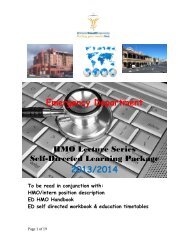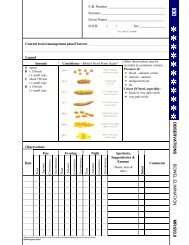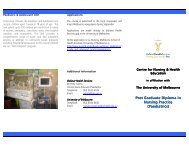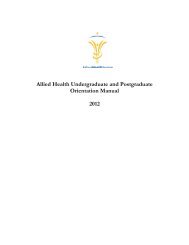Quality of Care Report - Ballarat Health Services
Quality of Care Report - Ballarat Health Services
Quality of Care Report - Ballarat Health Services
Create successful ePaper yourself
Turn your PDF publications into a flip-book with our unique Google optimized e-Paper software.
<strong>Ballarat</strong> <strong>Health</strong><strong>Services</strong> MassCasualty TraumaExerciseIn the event <strong>of</strong> human influenceddisasters such as the London andMadrid Bombings, incidents such asthe Kerang or Trawalla Train crashes ornatural disasters such as HurricaneKatrina or the Ash Wednesdaybushfires the community has anexpectation that hospitals will be ableto deal with the large numbers <strong>of</strong>injuries that would result. This type <strong>of</strong>mass casualty incident is known withinhospitals as a Code Brown andrepresents a significant alteration in thenormal operations <strong>of</strong> an impactedhospital.Planning for these events representunique challenges in the setting <strong>of</strong>limited budgets and increasing patientthroughputs. Undertaking masscasualty Incident plans, procedures andprocesses is made even more difficultas simulating a large number <strong>of</strong>“casualties” cannot be achievedwithout closing down vital facilities,removing staff from areas such as theEmergency Department, OperatingSuite and Critical <strong>Care</strong> Unit and even ifthat could be achieved the cost toconduct this type <strong>of</strong> “real” exercise isprohibitive.Despite this exercising remains a criticalendeavor, capable <strong>of</strong> validating plans,procedures and equipment as well ashighlighting areas for improvement.DHS recently introduced theEmergoTrain System (ETS), a real time,real resources, disaster simulation toolthat uses magnets known as “Gubas”to represent staff, casualties andresources. ETS has been internationallyaccepted in Sweden, UK, Netherlands,Germany and Japan and by the World<strong>Health</strong> Organisation. Using ETS allowsboth pre hospital and hospitalorganisations to simulate a masscasualty incident without impacting onnormal operations and at a minimalcost.Exercise Glass House: August 2008For Exercise Glasshouse the participantsranging from Ambulance Victoriaparamedics to hospital staff and up todivisional level EmergencyManagement staff had to respond to aincident where a truck carryingexplosives rolled over and crashed intothe State Government <strong>of</strong>fices on MairSt resulting in a significant explosion.The resultant impact affected over 130“Gubas”. A total <strong>of</strong> 95 were taken to<strong>Ballarat</strong> Base Hospital Emergencydepartment, including 22 selfpresenters and 20 were seen by StJohn <strong>of</strong> God Hospital (<strong>Ballarat</strong>) ED staffwho formed part <strong>of</strong> the exercise. Afurther 13 were transported to variousMelbourne hospitals. A total <strong>of</strong> 24succumbed to their injuries at thescene.The event involving 130 BHS staff andexternal emergency services personnelwas hailed by the exercise coordinatorsfrom the Department <strong>of</strong> Human<strong>Services</strong> and by observers as one <strong>of</strong> thebest run simulations ever.This exercise was unique in Victorianhealth in that it brought <strong>Ballarat</strong> <strong>Health</strong><strong>Services</strong> together with agencies such asCFA, Victorian Police, AmbulanceVictoria, SES and the MunicipalEmergency Coordination Centre. In thepast this type <strong>of</strong> exercise has onlyinvolved the health service andAmbulance service. However thisexercise showed that not only couldmultiple agencies be involved but thatthe notion <strong>of</strong> an “all agenciesapproach” to disaster managementcan be achieved successfully. As aconsequence <strong>of</strong> this exercise BHS isbeing held up as an example to otherVictorian <strong>Health</strong> <strong>Services</strong> in how tointegrate disaster responses acrossmultiple agencies.Don Garlick, Emergency ManagementCoordinator, said the Emergo TrainSystem was an educational tool fortraining and testing preparedness formajor accidents and disasters, usingthe principle <strong>of</strong> ‘learning by doing’.The exercise was conducted as thoughit was a normal day at <strong>Ballarat</strong> <strong>Health</strong><strong>Services</strong> where the organisation wasclose to 100 per cent capacity. “Theexercise is designed to put emergencyservices under pressure. It was basedon real time and real resources.” Donsaid. “So, for example, if a patientneeds to be transported to Melbourneby road ambulance that ambulance cannot be put back into use until thethree-hour turn around time iscompleted.” One <strong>of</strong> the most pleasingaspects <strong>of</strong> the exercise was theleadership demonstrated by the BHS<strong>Health</strong> Service Incident ManagementTeam. “There were particular positivereferences by outside agencies andstaff well experienced in emergencymanagement to the way that the BHSIncident Management Team conductedthe response.”There was some great work carried outby all those involved and it allowedstaff to deal with all variables that mayoccur in a major incident or disaster.BHS will not rest on its laurels howeverwith close examination <strong>of</strong> the exercise,feedback and evaluation to becollected and collated with a report tobe generated on any improvementsthat can be implemented.41<strong>Ballarat</strong> <strong>Health</strong> <strong>Services</strong> <strong>Quality</strong> <strong>of</strong> <strong>Care</strong> <strong>Report</strong> 2007-08
















